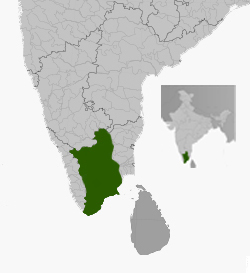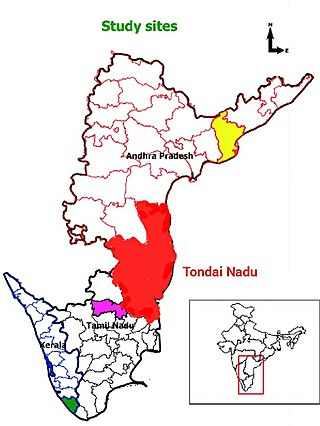
The Thanjavur Nayakdynasty were the rulers of Thanjavur in the 15th and 17th centuries. The Nayaks, who belonged to the Telugu-speaking Balija social group were originally appointed as provincial governors by the Vijayanagara Emperor in the 15th century, who divided the territory into Nayak kingdoms which were Madurai, Tanjore, Gingee and Kalahasthi. In the mid-15th century they became an independent kingdom, although they continued their alliance with the Vijayanagara Empire. The Thanjavur Nayaks were notable for their patronage of literature and the arts.
Nayaka dynasties emerged during the Kakatiya dynasty and the Vijayanagara Empire period. The Nayakas were originally military governors under the Vijayanagara Empire. After the battle of Talikota, several of them declared themselves independent.

Vellore Fort is a large 16th-century fort situated in heart of the Vellore city, in the state of Tamil Nadu, India built by the Emperors of Vijayanagara. The fort was at one time the imperial capital of the Aravidu Dynasty of the Vijayanagara Empire. The fort is known for its grand ramparts, wide moat and robust masonry.
Sriranga II was nominated in 1614 by Emperor Venkata II to succeed him as the Emperor of Vijayanagara. Sriranga was supported by a faction headed by Yachama Nayaka of Recherla Velama dynasty, one of the Venkata II's loyal viceroys and commanders and Nayak of Venkatagiri, but was not favored by a set of nobles headed by Gobburi Jagga Raya, brother of Venkata II's favourite Queen Obayamma.
Rama Deva Raya ascended the throne after a gruesome war in 1617 as the King of Vijayanagara Empire. In 1614 his father, Sriranga II the preceding King and his family were gruesomely murdered by rival factions headed by Jagga Raya, who was one of their kins. Rama Deva himself was smuggled out of the prison by Yachama Naidu, a faithful commander and the viceroy of earlier king Venkata II.
Sriranga III was the last ruler of the Vijayanagara Empire, who came to power in 1642 following the death of his uncle Venkata III. He was also a great grandson of Aliya Rama Raya.
Sriranga Deva Raya was the second Emperor of Vijayanagara from the Aravidu Dynasty. He reigned the empire from the fortress of Penukonda. Sriranga succeeded his father, Emperor Tirumala Deva Raya. After the fall of Vijayanagara to Turko-Persian Sultanates of Deccan, he carried out the restoration of the empire from Penukonda. His reign was marred with repeated invasions and subsequent losses of territory to his Turko-Persian Muslim neighbours.

Venkatapati Raya was the third Emperor of Vijayanagara from the Aravidu Dynasty. He succeeded his older brother, the Emperor Sriranga Deva Raya as the ruler of Vijayanagara Empire with bases in Penukonda, Chandragiri and Vellore. His reign of nearly three decades saw a revival in the strength and prosperity of the empire. He successfully dealt with the Turko-Persian Deccan sultans of Bijapur and Golkonda, the internal disorders, promoting economic revival in the realm. He subdued the rebelling Nayakas of Tamil Nadu and parts of present-day Andhra Pradesh.

The Madurai Nayaks were a Telugu dynasty who ruled most of modern-day Tamil Nadu, India, with Madurai as their capital. The Madurai Nayaks had their origins in the Balija Chetti merchants clans of present-day Andhra Pradesh. The Nayak reign which lasted for over two centuries from around 1529 to 1736 was noted for its achievements in arts, cultural and administrative reforms, revitalization of temples previously ransacked by the Delhi Sultans, and the inauguration of a unique architectural style.

The Thanjavur Maratha kingdom ruled by the Bhonsle dynasty was a principality of Tamil Nadu between the 17th and 19th centuries. Their native language was Thanjavur Marathi. Venkoji was the founder of the dynasty.
Pemmasani Ramalinga Nayudu was an army commander of a Vijayanagara military unit. An inscription dated to 1544 CE, which was found in Tallaproddatu, states that Pemmasani Ramalinga enjoyed the nayankara of the village. Phillip B. Wagoner who analysed 17th century Telugu text Rayavachakamu noted that it is not known whether Ramalinga Nayudu served Krishnadeva Raya or some later ruler.
The Venkatagiri estate was an estate in the erstwhile Madras Presidency. It was located in the Nellore district of the present-day Andhra Pradesh. The town of Venkatagiri was the administrative headquarters.

The Nayaks of Gingee (Senji) were Telugu rulers of the Gingee principality of Tamil Nadu between 16th to 18th century CE. They were subordinates of the imperial Vijayanagara emperors, and were appointed as provincial governors by the Vijayanagar Emperor who divided the Tamil country into three Nayakships viz., Madurai, Tanjore and Gingee. Later, after the fall of the Vijayanagara's Tuluva dynasty, the Gingee rulers declared independence. While they ruled independently, they were sometimes at war with the Tanjore neighbors and the Vijayanagara overlords later based in Vellore and Chandragiri. The Gingee Nayaks had their origins in the Balija Merchant clans of present-day Andhra Pradesh.

The Nayakas of Kalahasti were a line of rulers of Kalahasti and Vandavasi principalities. Members of the group include Damarla Chennapa Nayaka, after whom the city of Chennai is named. The Kalahasti Nayaks had their origins in the Velama warrior clans of present-day Andhra Pradesh. These Nayakas served as vassals of the late Vijayanagara Empire, then held by the Aravidu Dynasty and headquartered at Chandragiri and Vellore.
Vijaya Raghava Nayak was the fourth and last king of Sevappa Nayak's line. He ruled from 1634 to 1673. In 1673, Vijaya Raghava Nayak was defeated in battle by the Madurai Nayak king Chokkanatha Nayak who captured and beheaded him.
Gobburi Jagga Raya was a de facto King of Vijayanagara Empire on behalf adopted nephew named Chenga Raya, a rival claimant to the Vijaynagara thorne. He was the brother of Venkata II's favourite Queen Obayamma who was bequeathed the Pulicat region and belonged to the Gobburi family of Nayaks under the Vijayanagar Empire.
Damarla Chennappa Nayakudu or Chennapa Nayak, Damarla Chennapa Nayaka was a Nayak ruler of Kalahasti and Vandavasi under the suzerainty of Vijayanagar emperor Venkatapati Raya. He was also the Dalavoy or the Commander-in-Chief of the emperor. He belongs to the Velama caste. He married Akkamamba, the daughter of Venkatagiri ruler Velugoti Kasturi Ranga and younger sister of Velugoti Yachama Nayaka. The line of Nayaks were chieftains during the Vijayanagar empire and attained full power after its decline, becoming independent Nayaks.

Tondaimandalam, also known as Tondai Nadu, is a historical region located in the northernmost part of Tamil Nadu and southernmost part of Andhra Pradesh. The region comprises the districts which formed a part of the legendary kingdom of Athondai Chakravarti. The boundaries of Tondaimandalam are ambiguous – between the river basins of Penna River and Ponnaiyar River. During the reign of Rajaraja I, this region was called as Jayankonda Cholamandalam.
This battle caused complete destruction of the already declining Vijayanagara Empire. It was a civil war fought by the claimants for the kingship of the Vijayanagara Empire. Jagga Raya challenged the Sriranga Authority on behalf of his nephew.
Pedda Koneti Nayak was a governor of Penukonda under the Vijayanagar Empire who later proclaimed his independence and founded the Penukonda Nayak kingdom. He reigned from 1635 to 1652.He ruled Penukonda, Rayadurgam and Kundurpi Forts.








